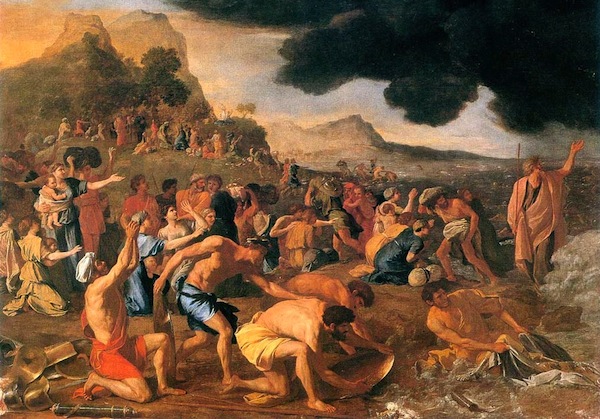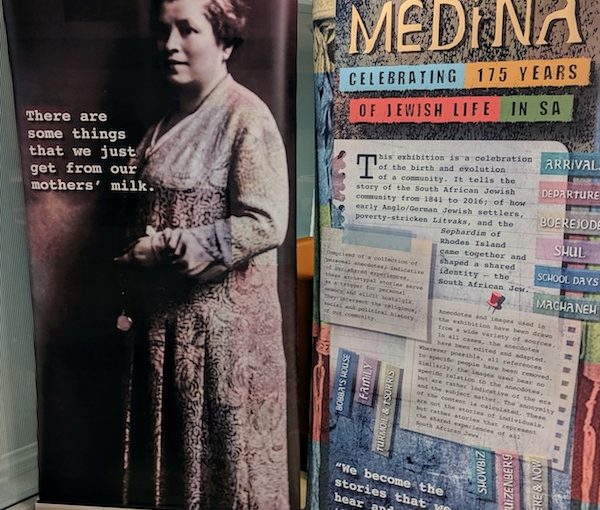“The Crossing of the Red Sea” by Nicolas Poussin, 1634. (photo from wikimedia)
We are a people with many memories, many stories, and who we are has been shaped by the stories we remember and tell.
More than any other holiday, Pesach is about remembering and passing that memory down to the next generation. Every Jew is commanded to see themselves as if they came out of Egypt, and to tell their Egypt story to their children. The telling of this story is not mediated by teachers or rabbis, nor is it told in a communal framework. The setting of the seder is one of family and immediate friends, and the responsibility is upon every one of us to decide how we convey the story.
What makes this particularly challenging is that, beyond the complicated family dynamics, a Haggadah that is deeply problematic and different sensibilities with regard to what needs to be done, we have inherited two different stories. The challenge is not merely how to tell the story, but which story to tell.
One story, which dominates much of the Haggadah, not to speak of the story as told in the Torah, focuses on Pesach as a story of exodus, of the Jewish people being freed by God from the slavery of Egypt. “I am the Lord. I will free you from the labours of the Egyptians and deliver you from their bondage. I will redeem you with an outstretched arm and through extraordinary chastisements. And I will take you to be my people, and I will be your God.” (Exodus 6:6-7)
More than freedom and salvation, Pesach is a story of the election of the Jewish people, as God pours down God’s wrath on those who enslave the chosen ones and redeems us out of the hands of Egypt to be God’s chosen people. Each plague, told and magnified, is an expression of love, a gift of betrothal of God to us, an offering that bonds us to one another. “I the Lord am your God who brought you out of the land of Egypt, the house of bondage: you shall have no other gods besides me.” (Exodus 20:2-3)
One of the core consequences of this election narrative under Jewish law is the sanctioned discrimination between Jew and non-Jew, between the Children of Israel and the nations of the world. Because God saved us, all of us, from the slavery of Egypt, Jews are all equal, and no Jew can take another Jew as a slave. However, those who are not the recipients of the gift of exodus, the non-Jews, can become our slaves (Leviticus 25). When we go to war, even wars of aggression, the God who took us out of Egypt will always fight on our side, because the moment of election creates an us-them dichotomy in which God is always with us (Deuteronomy 20). Idolatry is neither false nor futile. It is the worship allotted by God to the non-elected. We, the chosen people, are alone commanded to worship God. The God who saved us in Egypt is our God alone (Deuteronomy 4).
This tale of the story of Egypt finds its culmination in our traditional Haggadah, in which one of its concluding prayers is a petition to God to “Pour out your wrath on the nations that do not know you…. Pursue them with anger and destroy them from beneath the heavens of the Lord.”
There is a second story of Pesach, a story in which neither the exodus nor its accompanying plagues takes central stage, but rather the hundreds of years of our subjugation in Egypt. It is to this memory that the core symbols of the holiday – matzah, the poor person’s bread, charoset, the paste that resembles mortar, and maror, the bitter herb, which cause us to relive the experience of pain – all direct us.
It is this memory that shapes the most-repeated commandment in the Torah: “The stranger who resides with you shall be to you as one of your citizens: you shall love him as yourself, for you were strangers in the Land of Egypt.” (Leviticus 19) The story of Egypt is not one of us-them, but of us being them, of us being members of the community of the downtrodden, and the subsequent obligation to treat all who are in need, Jew and non-Jew alike, as equal members of our society.
In an interesting twist on this story, the Ten Commandments obligate us to rest on the Sabbath, “so that your male and female slave may rest as you do. Remember that you were a slave in the Land of Egypt, and the Lord your God freed you from there with a mighty hand and an outstretched arm: therefore, the Lord your God has commanded you to observe the Sabbath day.” (Deuteronomy 5)
It is not merely that because we once were slaves we are bonded to all those in need. The redemption from Egypt is no longer exclusively the moment of election of us, but rather an expression of God’s care and compassion for all who are enslaved. Both our slavery and our salvation unite us with God, in a common mission to bring freedom and equality to our world.
It is with this idea that we begin to tell the story of Egypt in the traditional Haggadah. “This is the bread of affliction that our forefathers ate in the Land of Egypt. All who are hungry let them come and eat.” All, and not merely fellow Jews.
Pesach is a tale of two stories. Each has shaped who we are. As we tell our stories and pass them down to the next generation, it is our obligation to take responsibility for what will define us in the future and what will determine our religious and national identity. The choice is ours. As you tell the stories this year, choose wisely. Our future and the future of Israel depend on it.
Rabbi Dr. Donniel Hartman is president of the Shalom Hartman Institute and author of the 2016 book Putting God Second: How to Save Religion from Itself. Articles by Hartman and other institute scholars can be found at shalomhartman.org.


